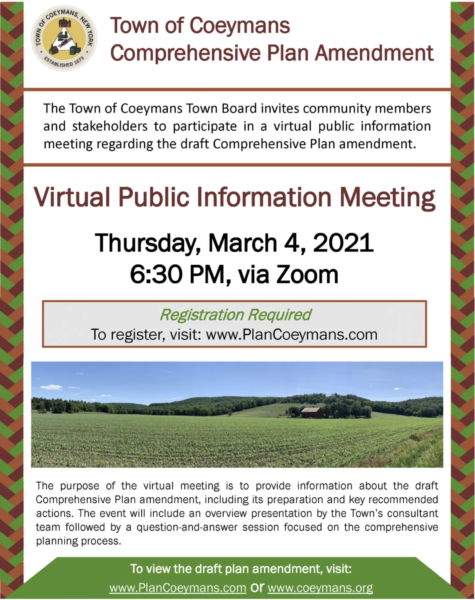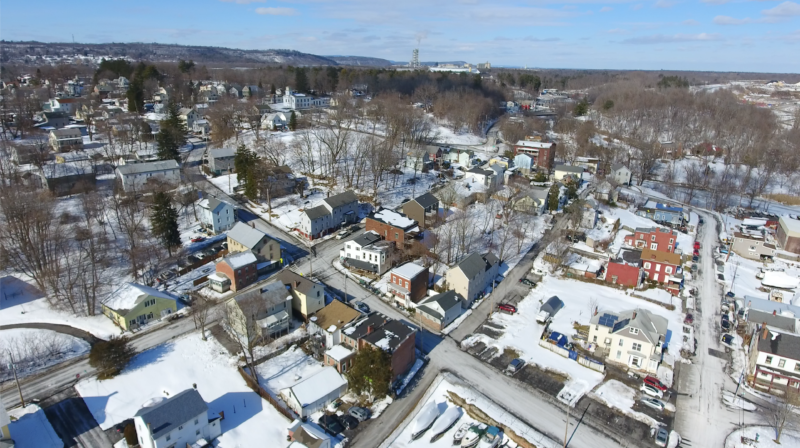To the Coeymans Town Board – regarding Draft Comp Plan for Coeymans:
Thank you for keeping the public comment period open on an issue as important as the Town’s Comprehensive Plan. Our members are especially concerned with two important issues: the vision of the Town’s future that is proposed and the process by which that vision was agreed. We also have a few questions about the what happens once the Comp Plan has been adopted.
The following letter lists our questions. We are submitting them now, while the Public Hearing is still open and we will post a copy of this letter online, as well as sending it to local media. I hope you will take these questions seriously in order to secure the trust and confidence of all residents of Coeymans.
We thank you for your attention.
THE COMP PLAN’S VISION FOR THE TOWN
Expansion of Industry
Industrial activity currently occupies 11% of the Town’s area, mostly near residential areas of Ravena and the Hamlet of Coeymans from Route 9W to the Hudson River. Since 2000, population has declined as industry has expanded.
Existing 1960s zoning has large areas set aside for industry and industrial buffers. Much of that area is still wooded or undeveloped. In 2006, people involved in the Comp Plan called for the expansion of business, but did not want more industry. In 2020, most people surveyed for the Comp Plan said again that they did not want more industry in Town. However, the draft Comp Plan calls for industry to expand along the Hudson River and NY Route 144.
Comp Plan says: on p. 13: A significant opportunity in the Town is the growth and expansion of industry along the riverfront and along route 144. The growth of the Port of Coeymans and the Coeymans Industrial Park, Lafarge North America, and the development of additional industrial parks along NY State Route 144 create numerous opportunities for employment and support for the local economy and school system. (p. 13)
Questions re industrial expansion
- Where else does the Plan expect to see industrial expansion?
- What type of industry is expected to expand in Coeymans?
- How much of the industrial growth do you believe will be devoted to increasing waste management?
- Has the Comp Plan considered reducing the area designated as industrial?
Balance industry, environment and public health
Comp Plan recommends, p. 14: ED6: Balance the protection of the environment and public health with the expansion of industrial development.
Question re balance of industry, environment & public health:
- What might be the impact of industrial expansion on where people are currently living?
- How do you plan to keep a balance between industrial development and people’s quality of life?
- How do you plan to balance industrial development with environmental protection?
- The Hudson River, Coeymans Creek and the surrounding natural areas along NY route 144 are valuable environmental, social and historical assets. Why is industrial development targeted at this area?
- What is the Comp Plan’s vision for protecting the areas around the Hudson River, Coeymans Creek and local residents if industry expands on the Riverfront and Route 144?
Challenges of industrial development
The Comp Plan recognizes there are challenges that come with industrial development, including increased truck traffic on residential streets, especially Church St and Main Street in Coeymans as well as Main St, Ravena, and north on Route 144. In an hour and a quarter on a Wednesday morning in February, 52 large large industrial trucks went up Church Street, more than one every two minutes. Over three days that week along Coeymans Main Street, 90 industrial trucks went by during 20 hours of observation, one every ten minutes. Small delivery trucks and vans were not counted, only large dump trucks and semis.
There is also the challenge of declining business activity on Main St in Ravena and Coeymans.
Questions re challenge of industrial development:
- How does the Comprehensive Plan propose addressing the challenges presented by significant industrial growth in the Coeymans Industrial Park, the riverfront and along NY Route 144?
- To what extent did the process consider the impact of industrial expansion over the past 15 years?
- What is the vision of the Comp Plan for eliminating industrial vehicles in residential and commercial areas?
- Is increased industrial activity and traffic expected to help restore small businesses in Coeymans, especially on the Town’s two Main Streets in Ravena and Coeymans?
- How many acres of land does the Comp Plan believe will be converted to industrial activity? What environmental protection will be required?
- What is the relationship between the vision for industrial expansion and the recent amendments to existing laws concerning Solid Waste management and Clean Air? For Solid Waste Law, amended July 2020 and Clean Air Act, amended November 2020.
- Industry has expanded but the population has declined. Did your process consider the possibility that more industry drove people out of the Town?
Additional questions on changes to the Solid Waste, Zoning & Clean Air Laws:
- Why was the Solid Waste law was changed in July 2020?
- Before the law permitted the Town to run a solid waste management, now the amended law permits anyone holding a permit from the Town to run a transfer station.
- Why was this change made?
- What kind of waste will this transfer station be permitted to take in?
- Where will it come from?
- How much waste is involved?
- Where would such a transfer station be located?
- Where are you planning to put this transfer station?
- Has the work on the transfer station began? Explain.
- Are there permits in place?
- What materials would be permitted to be imported into this transfer station?
- How do we know that for sure?
- Previous law did not allow any solid waste to be imported to any site in Coeymans. Now the law permits that solid waste to be imported to a site permitted by the Town.
- Why did the Board make this change to the law?
- Were you aware that the Town vigorously fought to prohibit the importation of solid waste into the Town?
- Explain.
- How is this changed law consistent with the expressed vision in the Comp Plan to balance the protection of the environment and public health with the expansion of industrial development?
The Hudson River shoreline & community
According to the Comprehensive Plan, p. 19, Coeymans has approximately 4.4 miles of Hudson River shoreline which is identified as a tidal shoreline habitat. This is considered a globally rare freshwater tidal habitat and is designated as a Significant Coastal Habitat by the New York Department of State. The Comp Plan states that Environmental and economic resiliency are inextricably linked to one another. Utilizing natural resources in a sustainable way ensures that those resources are available to the community for future generations to come. (p.20)
The Hamlet of Coeymans is the oldest settled part of the Town, with a history dating back over 300 years. There is no mention of this history or a vision for the Hamlet in the Comprehensive Plan.
Questions re Hudson River shoreline & community:
- What is the Comp Plan’s vision for the water front?
- How much of the 4.4 miles of Hudson shoreline will be dedicated to heavy industry?
- What is the vision for protecting the Hudson shoreline as proposed in the Comp Plan?
- What is the role of the Coeymans waterfront park?
- What is the vision of the Comprehensive Plan for the Coeymans Hamlet community?
- How does the Comp Plan envision the protection of historic resources in Coeymans, in the Hamlet and elsewhere?
PROCESS & PARTICIPATION IN DRAFTING THE COMP PLAN
The COVID pandemic made it virtually impossible for groups of residents to meet with the firm preparing the Comprehensive Plan. However, surveys and information tables were used and five stakeholder groups were convened, separately, each for one hour.
Questions re process & participation:
- What was the process for deciding that industry development along the riverfront and route 144 needs to be expanded?
- As those most affected by recent industrial growth, were the residents of North Coeymans, the Hamlet and Ravena consulted and did they endorse industrial expansion?
- How many residents of Coeymans in total were consulted, by any method, during the drafting of the Comp Plan?
- How many hours were spent in discussions with residents?
- How many people in the stakeholder groups were residents from the Hamlet of Coeymans or North Coeymans or Ravena north of Main St?
- How often did M.J. Engineering meet with the Town Board to discuss the Comprehensive Plan?
- How many hours were spent in discussion with the Town Board, or members of the Town Board?
- How were participants in the Stakeholder groups selected?
- Did the participants come from the different geographical areas of the Town and different social groups?
- How would you describe the balance of representation from business and industrial interests, versus the representation of residents and voters in Coeymans?
- Given the emphasis on industrial development, what are the plans for conducting a Study of the Cumulative Impact on Industrial Development since 2006? Such a study is needed before the Town adopts this comprehensive plan.
- If there are no plans to do a Cumulative Impact Study, why not?
NEXT STEPS
We understand that the Comprehensive Plan provides a vision of the Town’s future. However, a vision needs to be implemented and that will include new zoning. There is currently a 6-month moratorium on zoning, to allow time to finish and approve the Comprehensive Plan.
What happens next before the moratorium ends and afterwards?
Questions re next steps:
- What redrafting might be done before the Comp Plan is voted on by the Town Board?
- What other approvals are needed from NY State or Albany County before this plan can be adopted?
- When will discussions and work begin on revising the zoning?
- Who will draft the new zoning map, definitions, and rules?
- What opportunities will there be for public participation in the zoning discussions?
Thank you for your attention to these questions. We look forward to your answers and to a brighter future for everyone living in Coeymans.



